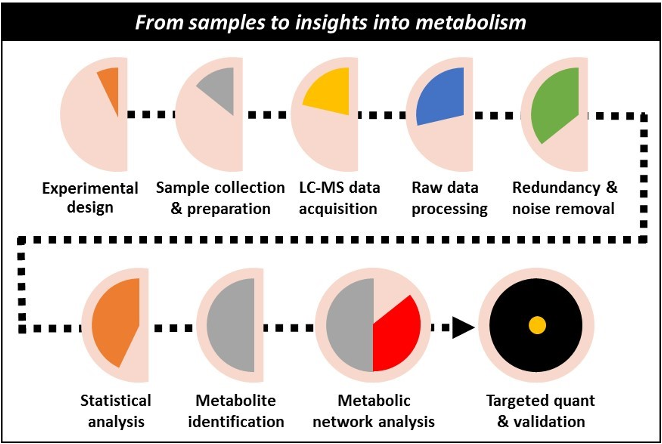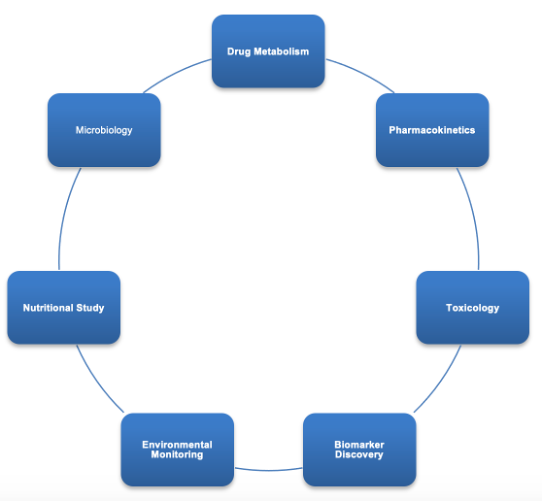Metabolite Identification Services
Background
Metabolism information is key to understanding drug safety and efficacy. Among them, metabolite identification runs through the entire process of drug development.
 Fig.1 Metabolic processes.1
Fig.1 Metabolic processes.1
-
In the early stages of drug development, metabolite identification can be used to identify metabolic soft spots to improve PK properties, or to identify active metabolites to address PK/PD issues.
-
During the lead optimization phase, metabolite identification helps screen lead compounds with low bioactivation potential and low risk of drug-drug interactions.
-
In the later stages of drug development, metabolite identification is used to guide the selection of animal species for preclinical safety assessment.
-
In the preclinical and clinical research phases, metabolite identification studies of radioisotope-labeled drugs provide a quantitative understanding of the metabolites of drugs in systemic circulation and excretion.
Our Service
Soft Spot Identification Service
-
The traditional metabolite identification process not only requires long-term LC-MS analysis to ensure chromatographic separation between metabolites and biological matrix components, but also requires a lot of manual data interpretation. Creative Biolabs provides a rapid, high-throughput method for identifying metabolic soft spots to meet throughput requirements in the early stages of drug discovery.
In Vitro Cross Species Comparison Service
-
Creative Biolabs offers in vitro cross species comparisons, which use in vitro models to perform experiments to assess similarities and differences in biological responses between different species, such as drug metabolism, toxicity, or efficacy. This approach is valuable in preclinical drug development to assess the translational relevance of experimental results between animal models and humans.
-
Identification Type
In vitro incubation metabolite identification
-
Liver microsomes, S9, primary hepatocytes, lysosomes, tumor cells, whole blood, plasma, etc.
Metabolite identification in vivo
-
Plasma, urine, bile, feces, tissues and organs, etc.
Identification of reactive metabolites
-
GSH trapping
Metabolite Identification Process
You can always trust Creative Biolabs. We will provide a comprehensive service throughout the entire project process.
 Fig.2 Metabolite identification process.
Fig.2 Metabolite identification process.
Applications of Metabolite Identification
 Fig.3 Applications of metabolite identification.
Fig.3 Applications of metabolite identification.
Frequently Asked Questions
Q1: How to choose a metabolite identification method?
A1: Choosing the right metabolite identification method depends on several factors, including the nature of the metabolite, the complexity of the sample matrix, the sensitivity required, and the available resources. If you have questions about this, you can contact our technicians directly for the best advice.
Q2: What is soft spot identification?
A2: Soft spot identification involves a systematic analysis of metabolic pathways, cellular processes, or biological systems to identify points of vulnerability, sensitivity, or importance for physiological or pathological outcomes. This can be achieved through a combination of experimental techniques, computational modeling, and data analysis approaches.
The structural identification of drug metabolites is the core and difficult point of drug metabolism research. With rich experience in in vivo/5in vitro screening and evaluation, relying on advanced technology and instruments, the Creative Biolabs expert team has developed a research platform for the analysis and identification of DMPK metabolites, and formulated a series of perfect countermeasures for the difficulties in the experimental process, helping customers to quickly advance their R&D projects.
Reference
-
Ivanisevic, Julijana, and Elizabeth J Want. "From samples to insights into metabolism: uncovering biologically relevant information in LC-HRMS metabolomics data." Metabolites. (2019) 9,12 308.
For Research Use Only | Not For Clinical Use


 Fig.1 Metabolic processes.1
Fig.1 Metabolic processes.1
 Fig.2 Metabolite identification process.
Fig.2 Metabolite identification process.
 Fig.3 Applications of metabolite identification.
Fig.3 Applications of metabolite identification.
 Download our brochure
Download our brochure